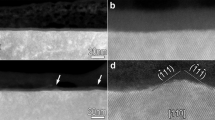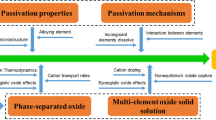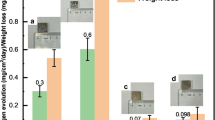Abstract
Controlled release technologies are often used to supply chemicals or drugs at given rates1,2. Release often occurs on contact with solution. However, some applications, such as corrosion protection, require containment of the active species in a reservoir and their slow release when needed. Conductive polymers have been used as reservoirs for corrosion inhibitors whose triggered release occurs by galvanic reduction or ion exchange3,4,5,6,7. This work shows one of the first examples of pH-controlled release of corrosion-inhibiting ions from an amorphous metallic coating where the pH change that triggers release is a consequence of the onset of corrosion. This corrosion-inhibition strategy provides further corrosion protection beyond the traditional roles of barrier and sacrificial cathodic protection using a metal coating8. For instance, zinc galvanizing provides sacrificial cathodic protection and acts as a barrier9, but does not supply inhibitor ions. In the coating described here, protection of an underlying structural alloy exposed at coating defects is demonstrated by inhibitor ion release in addition to barrier function and sacrificial cathodic protection.
This is a preview of subscription content, access via your institution
Access options
Subscribe to this journal
Receive 12 print issues and online access
$259.00 per year
only $21.58 per issue
Buy this article
- Purchase on Springer Link
- Instant access to full article PDF
Prices may be subject to local taxes which are calculated during checkout




Similar content being viewed by others
References
Cussler, E. L. Diffusion - Mass Transfer in Fluid Systems (Cambridge Univ. Press, Cambridge, 1997).
Pernaut, J. -M. & Reynolds, J. R. Use of conducting electroactive polymers for drug delivery and sensing of bioactive molecules. A redox chemistry approach. J. Phys. Chem. B 104, 4080–4090 (2000).
Kendig, M., Hon, M. & Warren, L. ‘Smart’ corrosion inhibiting coatings. Prog. Org. Coat. 47, 183–189 (2003).
Kinlen, P. J., Ding, Y. & Silverman, D. C. Corrosion protection of mild steel using sulfonic and phosphonic acid-doped polyanilines. Corrosion 58, 490–497 (2002).
Kinlen, P. J., Menon, N. & Ding, Y. A mechanisic investigation of polyaniline corrosion protection using the scanning reference electrode technique. J. Electrochem. Soc. 146, 3690–3695 (1999).
Cook, A., Gabriel, A., Siew, N. & Laycock, N. Corrosion protection of low carbon steel with polyaniline: passivation or inhibition? Curr. Appl. Phys. 4, 133–136 (2004).
Kendig, M. & Hon, M. Environmentally triggered release of oxygen-reduction inhibitors from inherently conducting polymers. Corrosion 60, 1024–1030 (2004).
Buchheit, R. G., Mamidipally, S. B., Schmutz, P. & Guan, H. in Proc. CORROSION/2000 Research Topical Symp. 67–92 (NACE, Houston, 2000).
Jones, D. A. Principles and Prevention of Corrosion (Prentice-Hall, Upper Saddle River, New Jersey, 1996).
Defense Science Board Report on Corrosion Control (Office of the Under Secretary of Defence For Acquisition, Technology and Logistics, Washington DC, 2004).
US Department of Labor: Occupational Safety and Health Administration. Occupational Exposure to Hexavalent Chromium (Unified Agenda No. 1979, June 2004); www.dol.gov/osha/regs/unifiedagenda/1979.htm.
Koch, G. D., Brongers, M. P. H., Thompson, N. G., Virmani, Y. P. & Payer, J. H. Corrosion costs and preventive strategies in the United States. Mater. Perform. 7 (suppl.), 2–11 (2002).
Kabasakaloglu, M., Aydin, H., Aydin, H. & Aksu, M. L. Inhibitors for the protection of aerospace aluminum alloy. Mater. Corros. 48, 744–754 (1997).
Shaw, B. A., Davis, G. D., Fritz, T. L. & Olver, K. A. A molybdate treatment for enhancing the passivity of aluminium in chloride-containing environments. J. Electrochem. Soc. 137, 359–360 (1990).
Hinton, B. R. W., Arnott, D. R. & Ryan, N. E. The inhibition of aluminium alloy corrosion by cerous cations. Met. Forum 7, 211–217 (1984).
Virtanen, S., Ives, M. B., Sproule, G. I., Schmuki, P. & Graham, M. J. A surface analytical and electrochemical study on the role of cerium in the chemical surface treatment of stainless steels. Corros. Sci. 39, 1879–1913 (1997).
Ilevbare, G. & Burstein, G. T. The inhibition of pitting corrosion of stainless steels by chromate and molybdate ions. Corros. Sci. 45, 1545–1569 (2003).
Hatch, J. E. Aluminum: Properties and Physical Metallurgy (ASM, Metals Park, Ohio, 1984).
Gao, M., Unlu, N., Jakab, M., Scully, J. & Shiflet, G. J. in Proc. Tri-Service Corrosion Conf. 1323–1330 (NACE, Houston, 2002).
Sinko, J. Challenges of chromate inhibitor pigments replacement in organic coatings. Prog. Org. Coat. 42, 267–282 (2001).
Szklarska-Smialowska, Z. Pitting Corrosion of Metals (NACE, Houston, 1986).
Pourbaix, M. Atlas of Electrochemical Equilibria in Aqueous Solutions (NACE, Houston, 1974).
Goldman, M. E., Unlu, N., Shiflet, G. J. & Scully, J. R. Selected corrosion properties of a novel amorphous Al–Co–Ce alloy system. Electrochem. Solid-State Lett. 8, B1–B5 (2005).
Hayes, S. A., Yu, P., O’Keefe, T. J., O’Keefe, M. J. & Stoffer, J. O. The phase stability of cerium species in aqueous systems I. E-pH diagram for the Ce-HClO4-H2O system. J. Electrochem. Soc. 149, C623–C630 (2002).
Xia, L. & McCreery, R. L. Chemistry of a chromate conversion coating on aluminum alloy AA2024-T3 probed by vibrational spectroscopy. J. Electrochem. Soc. 145, 3083–3089 (1998).
Jakab, M. A., Presuel-Moreno, F. & Scully, J. R. Critical concentrations associated with cobalt, cerium and molybdenum inhibition of AA2024-T3 corrosion: delivery from Al-Co-Ce(-Mo) alloys. Corrosion 61, 246–264 (2005).
Chen, G. S., Liao, C. M., Wan, K. C., Gao, M. & Wei, R. P. in Effects of Environment on Initiation of Crack Growth, ASTM STP 1298 (eds Van Der Sluys, W. A., Piascik, R. S. & Zawieruca, R.) (ASTM, West Conshohocken, 1997).
Rokhlin, S. I., Kim, J. -Y., Nagy, H. & Zoofan, B. Effect of pitting on fatigue crack initiation and fatigue life. Eng. Fract. Mech. 62, 425–444 (1999).
Ctibor, P. et al. Effect of the in-flight behavior of particles on the amorphous content of metallic coatings under thermal spray conditions. High Temp. Mater. Proc. 8, 381–395 (2004).
Carvalho, D., Cardoso, S. & Vilar, R. Amorphisation of Zr60Al15Ni25 surface layers by laser processing for corrosion resistance. Scripta Mater. 37, 523–527 (1997).
Acknowledgements
A Multi-University Research Initiative entitled ‘The Development of an Environmentally Compliant Multifunctional Coating for Aerospace Applications using Molecular and Nanoengineering Methods’ supported this work under the direction of Jennifer Gresham at AFOSR.
Author information
Authors and Affiliations
Corresponding author
Ethics declarations
Competing interests
The authors declare no competing financial interests.
Rights and permissions
About this article
Cite this article
Jakab, M., Scully, J. On-demand release of corrosion-inhibiting ions from amorphous Al–Co–Ce alloys. Nature Mater 4, 667–670 (2005). https://doi.org/10.1038/nmat1451
Received:
Revised:
Accepted:
Published:
Issue Date:
DOI: https://doi.org/10.1038/nmat1451



